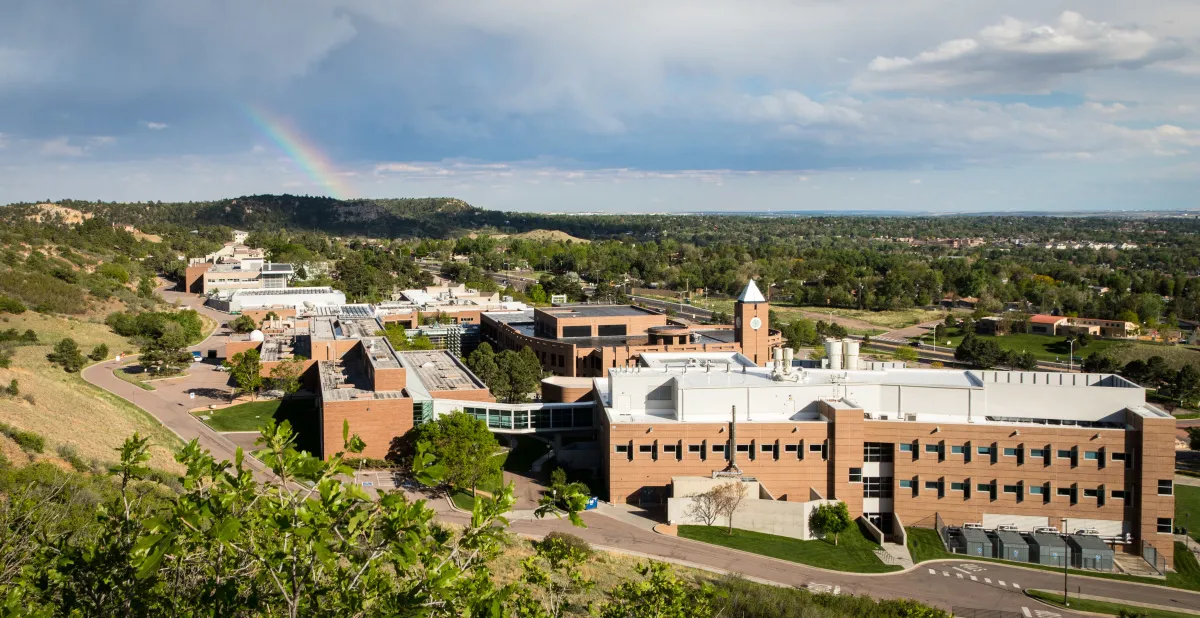
High Performance Buildings
About LEED®
The LEED® (Leadership in Energy and Environmental Design) Green Building Rating System™ is a third-party certification program and the nationally accepted benchmark for the design, construction and operation of high performance green buildings. LEED promotes a whole-building approach to sustainability by recognizing performance in five key areas of human and environmental health:
- Sustainable Sites
- Water Efficiency
- Energy and Atmosphere
- Materials and Resources
- Indoor Environmental Quality
A sixth category, Innovation and Design Process, awards points for exceptional performance above the requirements set by LEED and/or innovative performance in green building categories not specifically address by the LEED Green Building Rating System. Certified, Silver, Gold, and Platinum levels of LEED green building certification are awarded based on the total number of points earned within each LEED category.
LEED benefits include:
- Lower operating and life cycle costs
- Lower water and energy resource use and reduced greenhouse gas emissions
- Serve as a living laboratory and foundation for future sustainability efforts
- Demonstrate the university's commitment to sustainability and the health and wellness of building users.
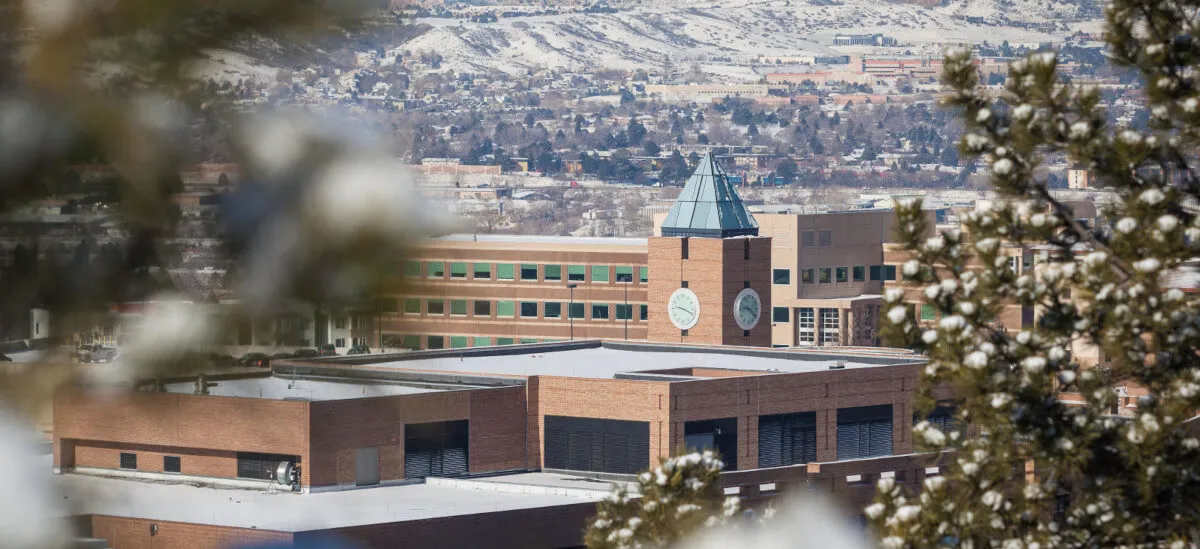
Osborne Center for Science and Engineering
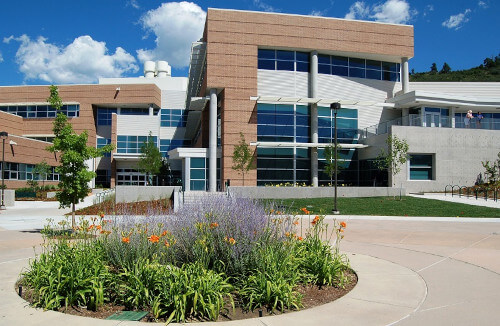
The new $56M Osborne Center for Science and Engineering was opened in May 2009 and accommodated full classes in fall 2009. The 156,000 square feet building with over 50 laboratories provides infrastructure for interdisciplinary teaching and research and fosters collaboration and innovation in engineering, science, biotechnology, national security and K-12 education. UCCS earned 40 points for the building, which achieved a LEED Gold certification from the U.S. Green Building Council. View the LEED checklist here.
Environmental and energy efficiency features of the building include:
- Funded by student fees, a 13.6 kW thin-film laminate solar photovoltaic system on the roof that provides electricity for the building,
- Ice storage system to shift electricity loads to off-peak hours, reducing costs and demand for electricity at the local coal-fired power plant,
- Heat recovery system to capture energy from the building exhaust air and reuse it to precondition the make-up air supply,
- Designed energy savings of 31% more than a baseline building,
- Designed water savings of 42% more than baseline buildings,
- A construction waste recycling rate of 94%.
View the interactive kiosk to learn more about our green Science & Engineering Building.
View the LEED poster for the building
Lane Center for Academic Health Sciences
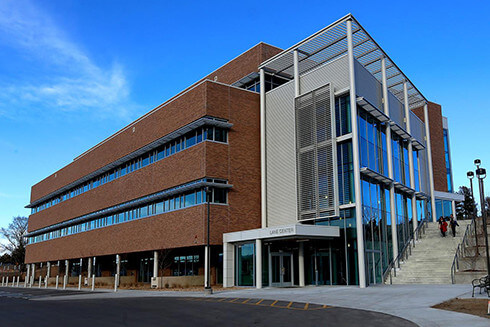
The 50,000 square foot Lane Center for Academic Health Sciences building is the first private-public partnership on the UCCS campus. The Center is the home of Peak Vista who provides primary care services to low-income, uninsured and underinsured working families (as well as others with access barriers and UCCS faculty and staff) within the Pikes Peak Region. As well, the center houses a branch of the CU Denver Anschutz Medical Campus and several UCCS clinics, including the Center for Active Living, Aging Center, Primary Care Clinic, Peak Nutrition Clinic, and the Veteran's Health and Trauma Clinic. The Lane Center achieved LEED Gold certification from the U.S. Green Building Council in 2015.
Gallogly Conference and Events Center
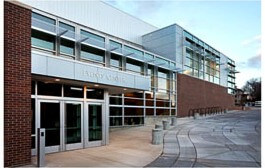
The $9M Conference and Events Center, which opened in January 2010, is an addition to the existing University Center of approximately 27,000 gross square feet located adjacent to the existing Berger Ballroom. The main interior space is a single-level multi-use space accommodating a gymnasium with collapsible bleachers to seat 1,400 spectators. UCCS achieved LEED Gold certification for the building. As part of the process to earn this certification, Renewable Energy Credits (RECs) were purchased in 2010 to cover 70% of two years of expected electricity use, or 265,878 kWh per year.
Roaring Fork
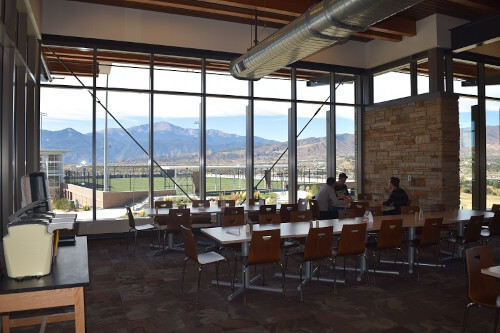
Each LEED building features:
- A carefully designed and constructed thermal envelope
- A very efficient mechanical system
- LED lighting and energy-efficient lighting control system
- Low-water use plumbing fixtures
- Low or no-VOC emitting materials
- Utilized significant jobsite recycling during construction
- Has sites that feature low-water use landscaping
- Set aside land on the bluffs for each building to preserve open space
- Features bike racks and other necessities for bicycle commuting
More information coming soon.
La Plata
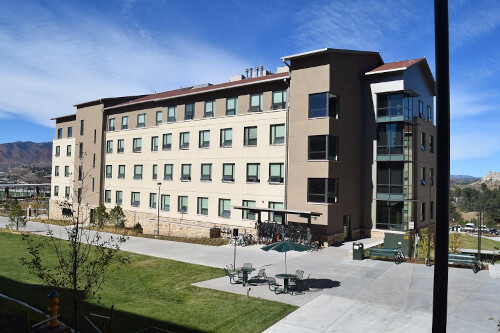
Environmental and energy efficiency features of the building include:
- Development Density & Community Connectivity
- Alternative Transportation
- Water Efficient Landscaping
- Water Use Reduction
- Optimize Energy Performance
- Enhanced Commissioning
- Enhanced Refrigerant Management
- Green Power
- Construction Waste Diversion rate of 60%
- Recycled Content of 23.37%
- 21.08% of it was regional materials
- Low-Emitting Materials
- Innovation in Design
San Juan
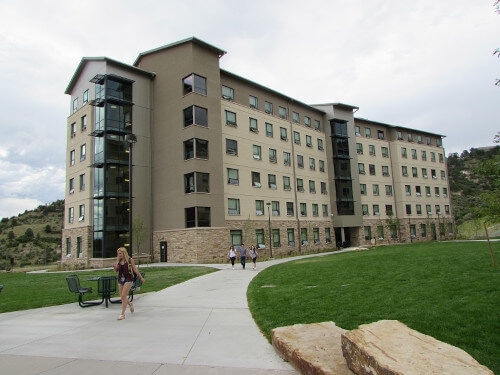
Environmental and energy efficiency features of the building include:
- Development Density & Community Connectivity
- Alternative Transportation
- Water Efficient Landscaping
- Water Use Reduction
- Optimize Energy Performance
- Enhanced Commissioning
- Enhanced Refrigerant Management
- Green Power
- Construction Waste Diversion rate of 60%
- Recycled Content of 23.37%
- 21.08% of it was regional materials
- Low-Emitting Materials
- Innovation in Design
Centennial Hall
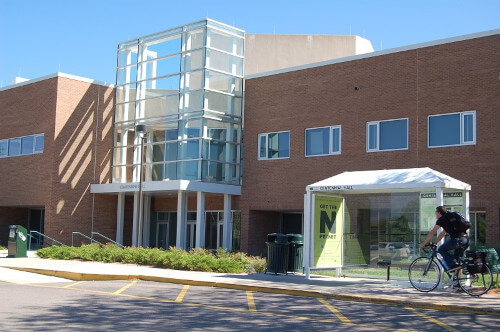
The former Science Building received a $17M environmentally-friendly renovation within the exterior walls, including lab, classroom, auditorium and office space. In February of 2012, LEED for Commercial Interiors (LEED-CI) was accomplished with a Gold level certification. Centennial Hall opened for classes in August 2010.
A 25 kW solar photovoltaic panel system on the roof was completed in December 2010 and now produces about 3% of the building's electricity needs; the system is expected to save UCCS approximately $2,900 annually in utility costs. The solar project was funded by student fees from the Spring 2008 Solar Referendum. Additionally, Renewable Energy Credits (RECs) were purchased in 2010 to cover 100% of two years of expected energy use or 833,680 kWh per year. View the LEED poster for the building here
Academic Office Building
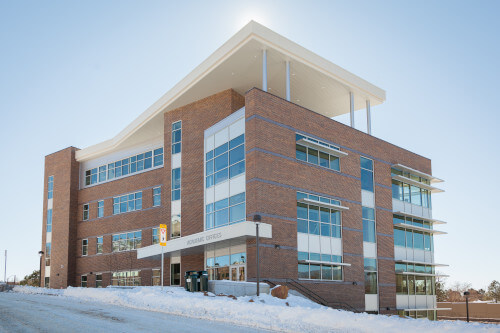
Completed in the summer of 2014, the 45,654 square foot Academic Office Building (ACAD) is the home for faculty in the College of Letters, Arts and Sciences. ACAD was the first campus building to be designed and constructed using a quasi-performance design-build process, where the architects, contractors, and UCCS participated in all phases of the project, particularly to meet the aggressive energy reduction goals. While the design-build process can take more time and effort up front, it reduces issues and costs later during construction and commissioning and result a in a higher-performing building. This building features direct/indirect evaporative cooling, which eliminates the need for a whole-building chiller and greatly reduces the energy use, 44% less than an equivalent building. Clerestory windows and light shelves provide natural lighting to 75% of the office spaces. An adjacent bioretention pond reduces stormwater runoff and reduces the need for irrigation. LEED Gold certification is pending for the building. View the LEED poster for the building here.
Gallogly Recreation and Wellness Center
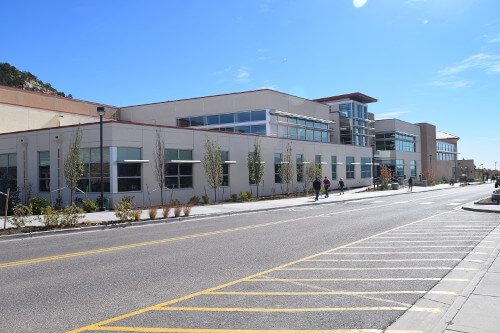
The Campus Recreation Center is the first public building in southern Colorado to earn LEED Gold certification and the first LEED certified building on the UCCS campus. The $12M, 54,000 square foot center was designed to meet the needs of a growing residential student body. Forty (40) LEED points were achieved -- see the detail here.
Environmental highlights of the Recreation Center:
- Solar thermal system to provide 2/3 of heat needed for swimming pool,
- Insulated Concrete Form walls provide a high insulation value of R39,
- 89% of the construction waste was recycled,
- The building is designed to be 38% more water efficient than a comparable conventionally built building,
- Views to the outside are available for 90% of spaces,
- The building is designed to be 32% more energy efficient than a conventional building.
UCCS received a $20,000 grant from the Governor's Energy Office (GEO) to fund planning efforts in sustainable design. The GEO provided an additional $25,000 to help fund the solar thermal system.
View the interactive kiosk to learn more about our green Recreation Center.
Copper and Eldora
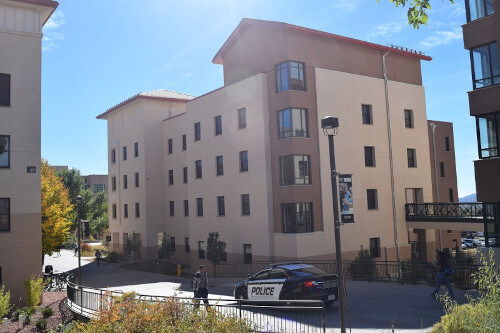
Completed in fall of 2013, Copper and Eldora Houses are home to nearly 200 students as well as the Office for International Affairs. The design projects have been officially approved for 'Designed to Earn the ENERGY STAR®' certification. This certificate recognizes that these design projects have met the Environmental Protection Agency (EPA) criteria for energy efficiency.
Cucharas
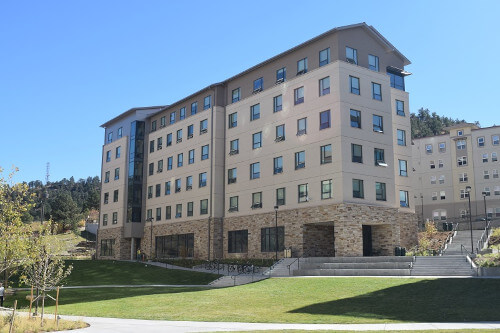
Environmental and energy efficiency features of the building include:
- Development Density & Community Connectivity
- Alternative Transportation
- Water Efficient Landscaping
- Water Use Reduction
- Optimize Energy Performance
- Enhanced Commissioning
- Enhanced Refrigerant Management
- Green Power
- Construction Waste Diversion rate of 60%
- Recycled Content of 23.37%
- 21.08% of it was regional materials
- Low-Emitting Materials
- Innovation in Design
Ent Center for the Arts
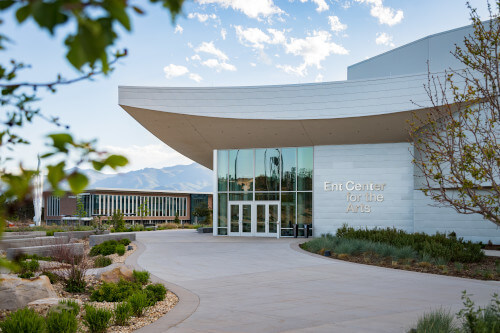
Each LEED building features:
- A carefully designed and constructed thermal envelope
- A very efficient mechanical system
- LED lighting and energy-efficient lighting control system
- Low-water use plumbing fixtures
- Low or no-VOC emitting materials
- Utilized significant jobsite recycling during construction
- Has sites that feature low-water use landscaping
- Set aside land on the bluffs for each building to preserve open space
- Features bike racks and other necessities for bicycle commuting
More information coming soon.
Hybl Sports Medicine and Performance Center
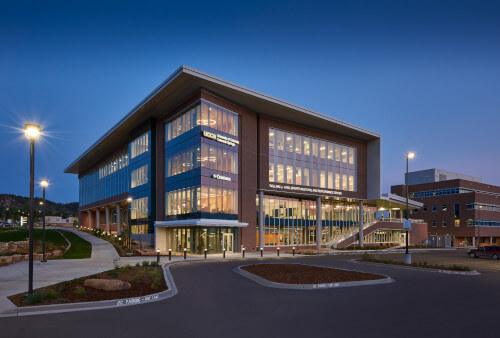
Each LEED building features:
- A carefully designed and constructed thermal envelope
- A very efficient mechanical system
- LED lighting and energy-efficient lighting control system
- Low-water use plumbing fixtures
- Low or no-VOC emitting materials
- Utilized significant jobsite recycling during construction
- Has sites that feature low-water use landscaping
- Set aside land on the bluffs for each building to preserve open space
- Features bike racks and other necessities for bicycle commuting
More information coming soon.
Alpine Field
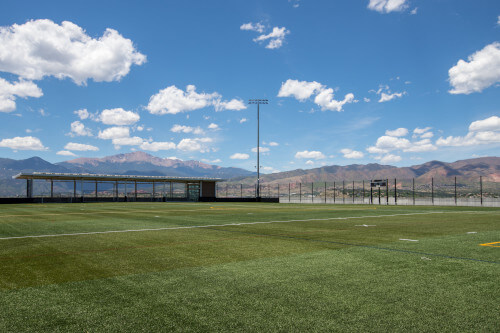
Info coming soon!